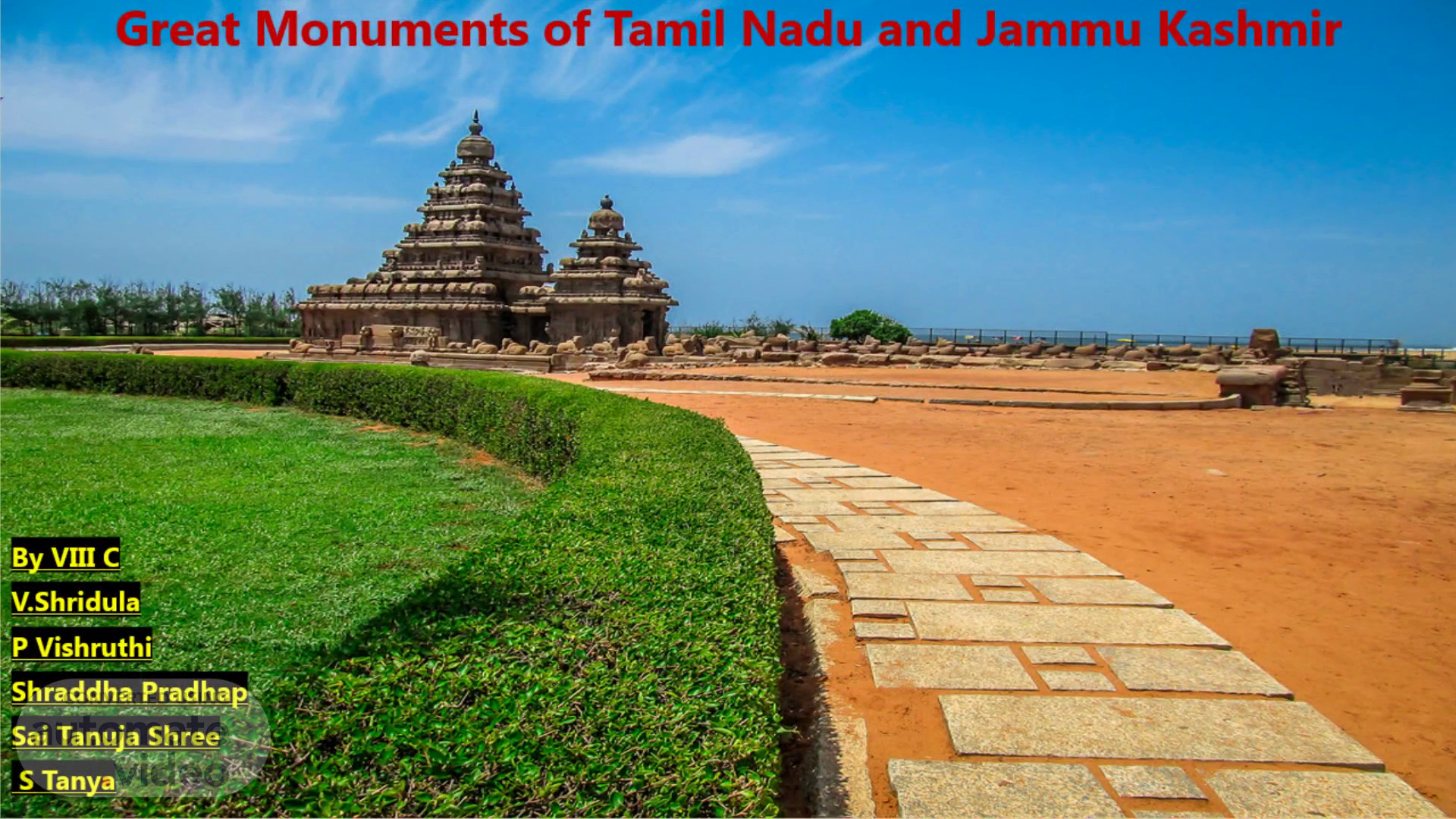
PowerPoint Presentation
Scene 1 (0s)
Great Monuments of Tamil Nadu and Jammu Kashmir By VIII C V.Shridula P Vishruthi Shraddha Pradhap Sai Tanuja Shree S Tanya.
Scene 2 (9s)
Tantalizing Tamilnadu and Mesmerizing Kashmir “The monumental at Mahabalipuram has encrypted the sculpture park which stands tall and large near the IT park of India, the Chennai. Meenakshi Amman temple, the icon of Madurai voted almost one of the Seven wonders, followed by Thirumalai Naicker Palace provides complete solace. The sunset in Kanyakumari sea is not of the sun but of the magical and mercurial Rainbow, as colours do sail into the farthest Indian ocean, our hearts do row into tranquility. Festivals and festivities are the marked by gaiety and glory. The forts and the temples, the hills and the falls, the flora and the fauna and the people and the country are so unique and universal in this Tantalizing Tamilnadu ” “Agar firdaus bar roo -e zameen ast , Hameen ast -o hameen ast -o hameen ast .” If there is a heaven on earth, it’s here, it’s here.. Kashmir ensures that despite the unrest and the violence, it’s sheer beauty continues to give meaning to Amir Khusro’s famous words..
Scene 3 (52s)
The crowning glory of temple architecture of South India, Meenakshi Amman Temple is one of the most popular attractions of Madurai in Tamil Nadu. It is dedicated to Goddess Meenakshi or Parvati, the consort of Lord Shiva, who here is known as Sundareswarar . The temple also featured in the list of 30 nominees for the ‘New Seven Wonders of the World’. A prominent landmark of Madurai, this temple is one of the most-visited ones in the state. Meenakshi Amman temple complex is spread across 45 acres with four entrances in four directions, and is segregated into a number of quadrangular spaces that have masonry walls. It is believed that King Vishwantha Nayaka reconstructed Madurai as per the rules of Shilpa Shastras and as the temple is in city’s center, its streets radiate like lotus and its petals..
Scene 4 (1m 58s)
Descent of the Ganges at Mahabalipuram, in the Tamil Nadu state India, is one of a group of monuments that were designated as a World Heritage Site since 1984.Measuring 96 feet long by 43 feet high, it is a giant open-air relief carved of the a monolithic rock. The monuments and sanctuaries were built by the Pallava kings in the 7th and 8th centuries. The legend depicted in the relief is the story of the descent of the sacred river Ganges to earth from the heavens led by Bhagiratha . The waters of the Ganges are believed to possess supernatural powers. The descent of the Ganges and Arjuna's Penance are portrayed in stone at the Pallava heritage site..
Scene 5 (2m 56s)
Perched on the majestic mountain of Hari Parbat, this massive fort was built during the Durrani Empire by Afghan Governor Atta Mohammad Khan in the 18th century. Overlooking the enchanting city of Srinagar, Hari Parbat Fort is also known as Koh- i -Maran. The complex of the fort comprises numerous structures including the shrines of Hindus, Sikhs, and Muslims.The first fortification on the site was done by Mughal Emperor Akbar in 1590 but he did not succeed to build a fort here. You can witness the breathtaking beauty of the city from the fort. There is a revered temple situated here, which is dedicated to Goddess Parvati and is known as Sharika Temple. It is a sacred shrine among Hindus and is the most visited place in Srinagar..
Scene 6 (4m 2s)
Built in the 19th century on the right bank of the Tawi River, Amar Mahal Palace is dedicated to Raja Amar Singh. It was designed by the French architect on the lines of the French Chateau. This majestic palace is an erstwhile residence of the Dogra Dynasty, which now has been converted into a museum. Amar Mahal Palace is a treasure trove of information and houses 25,000 antique books and many rare artifacts. The museum also exhibits the gold throne which is 120 kg along with Pahari miniature and Kangra miniature paintings. With the backdrop of Shivalik hills, the grandeur of the Amar Mahal Palace intensifies and makes it among the best historical places in Jammu to explore during the trip to this enchanting city..